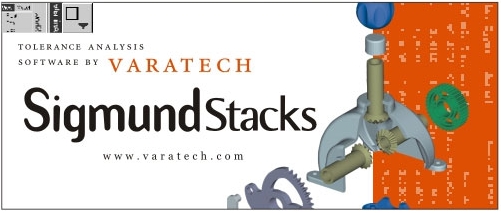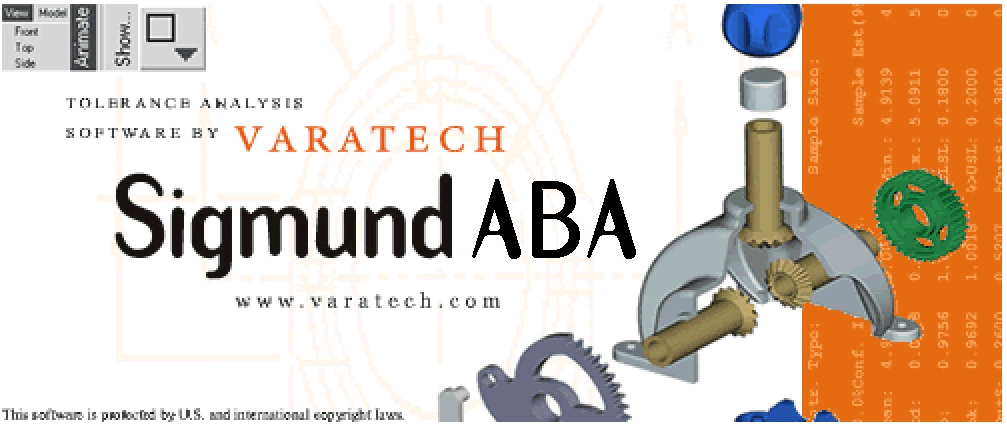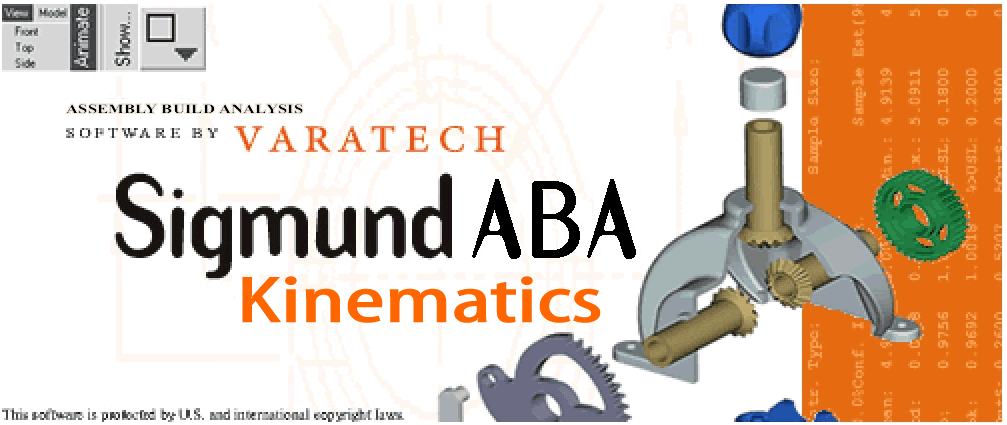|
Sigmund supports a suite of other CAD platforms like CATIA, Autodesk & UG NX and is compatible with them through its Stand Alone Application. Please click on the images below for detailed information on the Sigmund stand-alone solutions.

|
|
|
SIGMUND STACKS
SigmundStacks is a tolerance stack/variation analysis software that enables engineers to evaluate, optimize and validate assembly build quality, relative to piece part tolerance and assembly process variation early in the development phase before design solidification. SigmundStacks prevents costly tweaking delays at ramp-up as well as long-term variation problems.
FEATURES:
- Five analysis types including: Worst Case, RSS (Root Sum Square), Modified RSS, Monte Carlo Simulations, and Process Centering RSS Analysis (account for factors like mean-shifts due to tool wear).
- Predicts the quality of an assembly based upon predetermined build objectives (roll down studies), or determines the component tolerances to meet a given assembly build objective (roll up studies).
- Graphical identification and summary feedback of all build quality issues in existing/proposed design.
- What-if analysis to quickly evaluate multiple design concepts to reduce costly and time-consuming prototyping.
- Easy to use / quick to learn - Eliminates need for an expert user.
BENEFITS:
SigmundStacks enables engineers to quickly and efficiently evaluate the effects of component tolerances and assembly process variations on the quality of designed/manufactured products. SigmundStacks even includes a powerful optimization utility, which automatically optimizes all tolerances in a given model. These features accelerate an engineer’s understanding of the combined effects of component tolerances and assembly variation on a final assembly’s quality and performance.
- Easy to use menu-driven modeling capabilities reduce the user’s need to perform advanced mathematics or programming.
- Optimizes design and assembly process, adds precision where needed, and eliminates overly costly designs.
- Improve Quality and Reduce huge scrap, rework, retooling, recalls and warranty costs before they are incurred – High Return On Investment from use on just one program.
|
SIGMUND ABA STAND-ALONE
SigmundABA allows engineers to build a large number of virtual assemblies for evaluation with respect to predefined build objectives. It emulates manufacturing process variation following the ASME Y14.5M-1994 and 2009 GD&T standards as well as assembly process variations such as clamping sequence, part orientation, and gravity effects. SigmundABA's three-dimensional, parametric, real-time geometry representation and animation capabilities can accelerate an engineer's understanding of the combined effects of component tolerances and assembly variation on a final assembly's quality.
FEATURES/BENEFITS:
SigmundABA's powerful utilities greatly reduce modeling time and effort, and it's succinct reporting module provides all relevant information in a single-page, easy-to-interpret graphical format that relates to the Enterprise.
Some of the key benefits of SigmundABA are:
 Easy to use menu-driven modeling capabilities reduce the user's need to perform advanced mathematics or programming. Easy to use menu-driven modeling capabilities reduce the user's need to perform advanced mathematics or programming.
 Optimizes design and assembly process, adds precision where needed, and eliminates overly costly designs. Optimizes design and assembly process, adds precision where needed, and eliminates overly costly designs.
 Improve Quality and Reduce huge scrap, rework, retooling, recalls and warranty costs before they are incurred – High Return On Investment from use on just one program. Improve Quality and Reduce huge scrap, rework, retooling, recalls and warranty costs before they are incurred – High Return On Investment from use on just one program.
Development of a Sigmund assembly build analysis model follows an intuitive, step-by-step methodology that includes Component Geometry Creation, GD&T or Tolerance Emulation & Optimization.
|
SIGMUND ABA KINEMATICS
Sigmund ABA Kinematics is the World's only assembly build analysis tool that allows engineers to evaluate the 3-D variational effects of kinematic mechanisms and component tolerances on the quality of manufactured products. Sigmund provides engineers with an easy to use interface to evaluate the capability of their kinematic mechanisms and the component/assembly design, ensuring that assemblies go together 100% of the time, while meeting all the assembly performance criteria.
KEY FEATURES:
 Consider piece part/assembly variation and kinematic motion in the same environment. Consider piece part/assembly variation and kinematic motion in the same environment.
 Allows defining relative motion between multiple parts/components by using different kinematic joints, such as - primitive, revolved, cylindrical, universal, planar, ball, and bearing joints. Allows defining relative motion between multiple parts/components by using different kinematic joints, such as - primitive, revolved, cylindrical, universal, planar, ball, and bearing joints.
 Allows assigning different driver motion in a mechanism. Allows assigning different driver motion in a mechanism.
 Allows considering variation analysis in both open and closed loop mechanisms with zero to multiple degrees of freedom. Allows considering variation analysis in both open and closed loop mechanisms with zero to multiple degrees of freedom.
 Can animate kinematic motion and trace the range of motion for a specific feature at both nominal and deviated conditions. Can animate kinematic motion and trace the range of motion for a specific feature at both nominal and deviated conditions.
 Can evaluate thousands of outputs throughout the range of motion in mechanisms. Can evaluate thousands of outputs throughout the range of motion in mechanisms.
BENEFITS:
Sigmund ABA Kinematics can be used to resolve complex assembly problems for kinematic mechanisms, evaluate design improvements, identify important design characteristics, and determine optimal tolerances for parts and assemblies.
 Avoid creating multiple models by considering variation and kinematic motion at the same time.
 Allows accurate assembly of closed-loop kinematics mechanisms.
 Can identify non-build conditions because of actual and accurate constraints applied at specific joints.
 Can evaluate the effects of variation throughout the range of motion in mechanisms.
 Can compare them with the nominal range of motion relative to what you might see in an ADAMS model.
 Can generate automated reports showing multiple indices of information throughout the range of motion.
|
|






